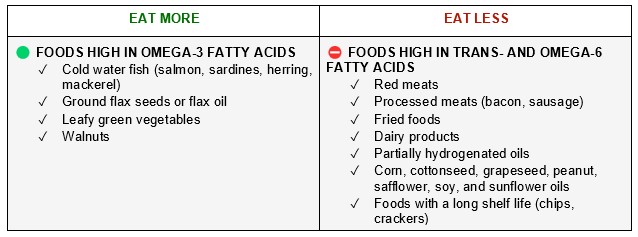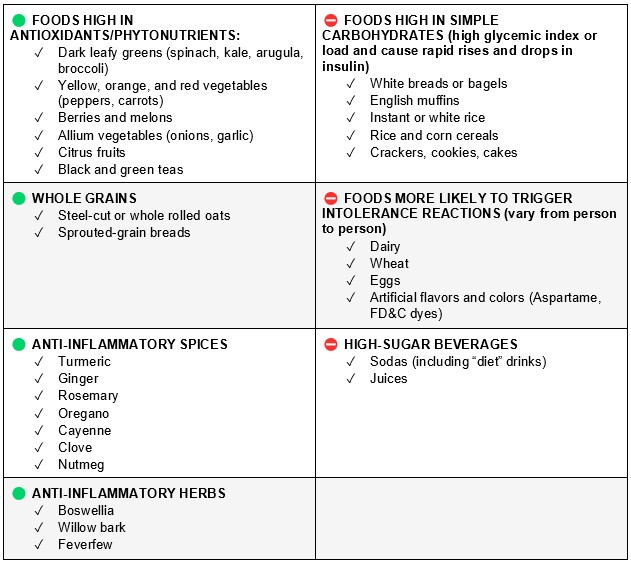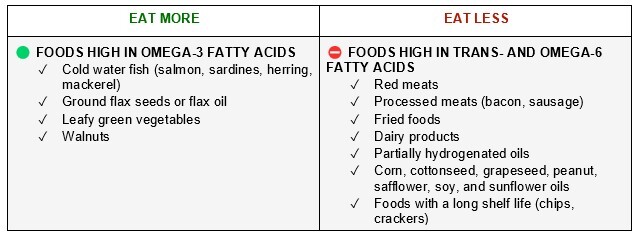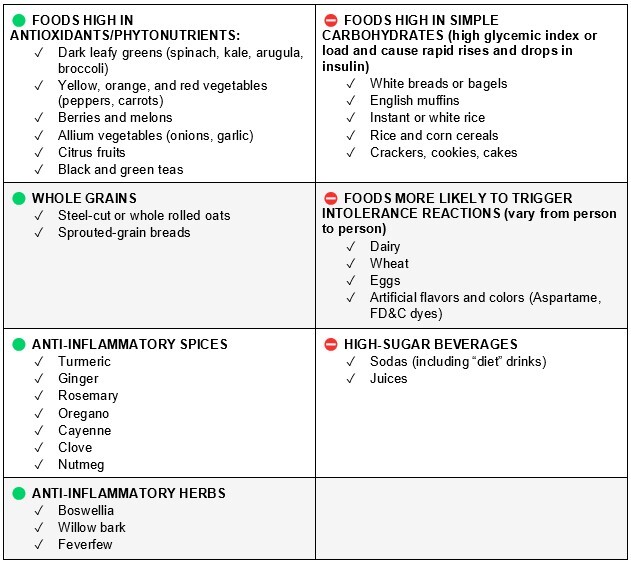Are you suffering from chronic joint and tendon pain, heart disease, diabetes, cancer, asthma or Alzheimer’s disease? Chronic disease is driven by inflammation. Inflammation can be a simmering flame or a wildfire wreaking havoc throughout your body. There are measures you can take in order to tame the fire of inflammation and gain a better quality of life. Prioritizing some basic lifestyle changes can help to manage many chronic illnesses and reduce your risk of their onset. An anti-inflammatory lifestyle focuses on healthy nutrition patterns and improving movement, gut health, sleep and stress.
What is inflammation?
Inflammation is a natural response of your body to protect you against injury, infection, foreign material or disease. It’s our bodies’ first defense of protection and is how our body activates the tools to heal. Without inflammation, our wounds wouldn’t heal, our injuries wouldn’t recover and we would be unable to fight infections. The initial swelling after you sprain your ankle is your body’s natural acute inflammatory response to bring all those good healing factors to heal and restore normal function. This acute “good” inflammation is short-lived and typically then allows the healing response to take over. Inflammation becomes a problem when it becomes chronic. Chronic inflammation is when that initial response overstays its welcome. It may be that simmering flame that persists and leads to ongoing pain, dysfunction or degenerative changes. Chronic Inflammation leaves your body in a state of a “war zone”. It depletes your antioxidants, increases your risk of blood clotting, delays wound healing and tissue regeneration and promotes cell aging and premature cell death. It is thought to be partially responsible for onset of many chronic illnesses such as heart disease, diabetes, cancer and some mental health conditions.
What causes Inflammation?
Many factors can cause inflammation in an individual. Infections such as viruses, autoimmune diseases and pollutants such as smoking and inflammatory foods are some common offenders. Many lifestyle behaviors may put you at risk of increased inflammation as well. Poor or reduced sleep such as that seen with shift work, can disrupt our circadian rhythm and alter gut microbiota leading to chronic inflammation.
What Do These Inflammatory Foods Do?
Our immune system is like a military ready to defend against intruders. When a foreign object like an invading microbe, chemical, or plant pollen enters our system, the “warriors of your immune system” are recruited and initiate an inflammatory response to fight the intruder. These Inflammatory foods trigger this response and may lead to inflammation at the gut as well as throughout the body. Inflammation may sometimes persist even when a non-significant foreign invader threatens the body. In this case, inflammation becomes an enemy.
What are key Anti-Inflammatory Diet patterns?
An anti-inflammatory diet is one that focuses on more plant-based or plant-forward eating patterns.The typical anti-inflammatory diet consists of vegetables, fruits, whole grains, nuts, fish, mushrooms and healthy oils. In addition to lowering body inflammation, an anti-inflammatory diet will help you with overall physical and emotional health. Most of these foods effectively boost moods and the overall quality of life.
Basic principles of an anti-inflammatory diet are:
✓ Limit added sugar
✓ Limit processed foods
✓ Eat fruits and vegetables
✓ Avoid cooking methods that can cause inflammation
✓ Eat fiber
✓ Avoid unhealthy fats
AVOID or LIMIT:
1. Limit added sugar: The American Heart Association (AHA) recommends no more than 100 calories (6 teaspoons or 25g) of added sugar per day for women and 150 calories (9 teaspoons or 38g) for men. To put that in perspective, a 12 oz can of coca-cola has 39 grams of total sugar or over 9 teaspoons! Ouch!
2. Limit processed foods: Processed foods are changed from their natural form and often depleted of their beneficial nutrients. Processed foods often have terminology like the following in the ingredients on their food label: enriched white flour and processed fats (hydrogenated oils, interesterified oils, monoglycerides, or diglycerides)
3. Avoid Cooking methods that can cause inflammation: Limit or try to avoid cooking with dry hight heat. Dry heat cooking can increase levels of Advanced Glycation End Products (AGEs) in your foods. High levels of AGEs in the body have been linked to the development of many diseases such as diabetes, kidney failure, Alzheimer’s and premature aging. Cook, stir fry, or sauté meats and vegetables in broth or water instead of oil to avoid production of these inflammatory compounds. If using oil, keep heat to medium to avoid smoking. Marinate meats in olive oil and sprinkle with spices and herbs before grilling and grill with lower heat to prevent charring.
4. Avoid unhealthy fats: Trans-fats and fats that are high in omega-6 fatty acids cause inflammation. These fats are found in many animal products and in many foods designed for a longer shelf life. A better choice are mono-unsaturated fats, like extra virgin olive oil. Omega-3 fats found in fish, fish oil or flax oil are recommended to decrease inflammation.
INCREASE or PRIORITIZE:
1. Eat fruits and vegetables: Consume 5-9 servings of vegetables and fruits per day, with more than half as vegetables. Mix it up with an array of different colors to get the benefits of many different phytonutrients. Deeply colored fruits and vegetables contain higher amounts of these protective phytonutrients. Half of your plate should be vegetables.
2. Eat fiber: Diets high in fiber are shown to decrease inflammation. A good goal is about 32 grams/day, ideally from a diet rich in whole grains, fruits, and vegetables.
3. Eat unrefined whole grain carbohydrates: A good start would be to double your vegetable intake and half your intake of refined carbohydrates aiming to eventually eat only unrefined whole grains.
4. Consume foods high in omega-3 fats: Eat two servings ( 4 ounces each) of fatty fish per week OR supplement with 1-4 g of combined EPA + DHA daily. Ratio of Omega-6 ( the bad omega fatty acid): Omega-3 (the good omega fatty acid) should be in the range of 2:1 to 4:1.
5. Eat more plant protein: Sources such as legumes, nuts, and seeds or lean animal sources of protein in moderate amounts are better options to decrease inflammation. Limit consumption of animal protein to 6 to 8 ounces by cooked weight per day. Choose lean meat such as skinless chicken and turkey, ground beef (90% lean, 10% fat), fish and shellfish and pork loin.
6. Spice up your meals: There are a number of spices and herbs that not only add flavor but have anti-inflammatory benefits such as garlic, turmeric, rosemary, ginger, oregano, cumin, and cayenne.
7. Eat mindfully: Take time to savor your meal. Be mindful or your portions. Prioritize both quality and quantity of your intake. Anything eaten to excess can be a potential detriment. Eating slower and stopping when not completely full allows your body to release the satiety signals that will prevent overeating.


What are other lifestyle measures that can help reduce inflammation and decrease overall pain?
✓ Eating anti-inflammatory foods
✓ Adequate exercise or being active
✓ Getting enough good quality sleep
✓ Managing stress well
✓ Managing weight
✓ Not smoking
✓ Limiting alcohol intake
Get Moving:
Exercise not only strengthens your muscles and joints but also boosts your metabolism and gives you a rush of endorphins. This contributes to an overall sense of improved mental and physical functioning. Every bit of movement can help but the American College of Sports Medicine (ACSM) recommends 30 minutes most days of moderate degree activity for a total of 150 minutes/week. This does not have to be continuous and can be broken into smaller intervals throughout the day (i.e 5-10 minute walk breaks during the day). Meeting this goal can help to lower blood pressure, increase insulin sensitivity, improve bone strength and joint mobility and reduce inflammation. Any activity that gets you moving is great, whether it be walking, running, hiking, yoga, pilates, HIIT, swimming, tennis, etc. Meet yourself where you are and aim to move more the next day until you meet your goal.
Prioritize Sleep:
Though everyone’s sleep needs are different, the majority of people need 6-8 hours to achieve refreshing sleep. Many factors may play in to someone having troubles achieving a good night’s sleep. When we sleep, our brain releases hormones and neurotransmitters such as leptin, cortisol and human growth hormone (HGH). HGH is usually released at the onset of our sleep cycle. On average a person undergoes around five sleep cycles a night which takes about 8 hours. HGH helps our body repair muscle tissue, metabolize fat, regulate insulin and keep inflammation under control. The markers of inflammation most notably affected by a lack of sleep include an increased risk of both type 2 diabetes and heart disease. Sleep also plays a direct role in the bodies management of stress, strength and endurance. So a poor night’s sleep may disrupt your insulin control and hinder your strength and endurance. This may lead to a vicious cycle of fatigue causing further poor lifestyle choices. A way to break this cycle is to allow yourself the designated 8 hour sleep allowance each night. Eventually, your body will fall in to the pattern of longer refreshing sleep.
Manage Stress:
Stress and anxiety are also triggers of inflammation. When you experience an uncomfortable emotion, your body is thrown into a flight or fight type process. A response similar to an internal invader occurs and your body releases inflammatory markers as a result. With further stress, the inflammation intensifies triggering the inflammatory cascade. Stress is a natural part of our life. There is positive stress and negative stress as well as acute and chronic stress. Positive stress helps us to achieve higher goals. Acute stress happens to most of us on a daily basis. Driving on the interstate and someone cuts you off or having a disagreement with a spouse may be sources of acute stress that can typically be resolved quickly. Chronic stress however, can wreak havoc causing long term consequences on your health. Chronic stress can disrupt immune function, lower energy levels, affect your cardiovascular health, lead to depression and sabotage your ability to lose weight. Unfortunately, many forms of chronic stress may be beyond our direct control, such as caring for an ill family member, living through a natural disaster or pandemic or financial insecurity due to a job loss. Though we cannot necessarily get rid of the source of stress, we can learn how to adapt and respond in a positive way to keep our life in balance. Some techniques that can help reduce stress are: deep breathing, meditation, practicing gratitude, journaling or seeking outlets through physical activity.
In addition to being board-certified in Sports Medicine, Dr Hammonds is also board-certified in Lifestyle Medicine. As part of your assessment and treatment plan, Dr Hammonds always takes a comprehensive approach by addressing underlying lifestyle changes that can help to improve your pain, functionality and overall quality of life.







